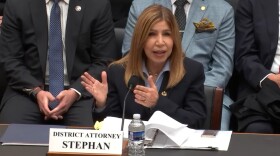On the surface, the new concert film Summer of Soul may easily read as a black alternative to the well-documented four days of Woodstock — the predominantly white music festival that got so much attention in August of 1969. But Woodstock, while avowedly anti-war and anti-imperialist, was also synonymous with sex, psychedelics, and rock & roll.
Each weekend from June 29 to August 24 in 1969, thousands of Harlem residents flocked to what is now Marcus Garvey Park. The stage featured extraordinary artists from the sisterly harmonies of The Staple Singers to headlining sets by B.B. King and Steve Wonder. Unlike Woodstock, these concerts were no sybaritic celebration of hippie counterculture, but a direct response to the profound losses and violence endured by Black activists and progressives that preceded that summer.
Non-violent and legislative attempts to dismantle institutionalized racism had led to a devastating series of political assassinations during the 1960s, most attributed to arcane conspiracy theories. Having lost Medgar Evers in 1963, Malcolm X in 1965, then both the Reverend Dr. Martin Luther King Jr. and Robert F. Kennedy in 1968, ordinary Black citizens were tired of counting martyrs.
The 1969 edition of the festival was a carefully coordinated reaction to these cumulative losses. Black America's acute sense of being forcibly denied both altruistic leadership and hope made the Harlem Cultural Festival about more than mere music. As musician and filmmaker Ahmir "Questlove" Thompson's strategic direction makes clear, these concerts were organized to reveal and encourage a new Pan-African push for social justice.
A global gathering in music and words
To tell the story of the 3rd Harlem Cultural Festival, Questlove intersperses brilliant performance footage with a mosaic of talking heads. We not only hear from people interviewed in '69, we also get contemporary reflections from surviving eye-witnesses who were adolescents or in their early 20s when they attended these concerts. Then as now, they witnessed money being wasted on wars and frivolous space flights that would be better spent solving critical ecological problems on earth.
One especially insightful segment is devoted to the Apollo 11 moon landing nationally televised during the summer of 1969. Questlove cuts away from grainy black and white NASA videos to show Walter Cronkite and other TV reporters interviewing unimpressed black festival goers. One articulate interviewee declares that the moon landing is in no way more important than the speakers and musicians celebrating black unity at Mount Morris Park. Another young man cooly condemns the waste of taxpayer money on space exploration when it could be used to eradicate poverty and racist oppression here on Earth.

As a musician himself, Questlove gives special attention to the amazing roster of musical talent. Out of 40 hours of film he and editor Joshua L. Pearson had to select the most representative moments, be they powerful Afro-Latin numbers delivered by deceased greats like Mongo Santamaria and Ray Barretto, or South African jazzman Hugh Masekela whose presence reminds us that he and countrywoman Miriam Makeba escaped the apartheid regime of South Africa to join musical forces with Black American protest singers.
But it was a lengthy set of gospel music that became the emotional lynch pin for an event dedicated to the legacy of civil rights martyrs like King and Malcolm X. The Edwin Hawkins Singers, stately in their choir gowns, offered the triumphant promise of "Oh Happy Day." Swinging evangelical combos delivered encouraging yet sardonic sermons over funky backbeats. The great soloist Mahalia Jackson, a close friend of the late Dr. King, gave voice to the collective need to grieve his sacrifice by singing his favorite hymn with an audibly broken heart. Jesse Jackson came onstage to announce that she and Mavis Staples would trade leads on "Precious Lord, Take My Hand," but Mahalia gives the younger singer most of the sorrowful verses, saving her own voice for powerful shouts and moans that convey a depth of feeling beyond words.

A city and community at a crossroads
Financially, the 1969 Harlem Cultural Festival was co-sponsored by the City of New York and the Maxwell House coffee company. Advance preparations for the event were so elaborate that a corporate sponsor was required to guarantee musicians would be paid and the event could be filmed. John Lindsay, a liberal Republican, was the Mayor of New York City from 1966-1973, and a staunch ally of the embattled black and brown residents of his city. In 1967, Lindsay became Vice Chair of the National Advisory Commission on Civil Disorders, established by President Johnson during the Detroit riots to investigate how best to prevent further urban unrest.
Sadly, LBJ chose to ignore the findings of the so called "Kerner Commission" which warned in part: "What white Americans have never fully understood—but what the Negro can never forget — is that white society is deeply implicated in the ghetto. White institutions created it, white institutions maintain it, and white society condones it." Shortly after this report went public in 1968, New York became one of the many American cities that erupted in street riots when Dr. King was shot. The Kerner Report suggestions had to be deployed by proactive mayors like John Lindsay before similar initiatives were widely implemented by the federal government. Lindsay and his advisors walked the streets of Harlem the night after King died. He listened to Black community leaders then set up summer job and lunch programs for young urban teens.
I myself would benefit from these programs once I came of age. My aunt, who ran a small business on 125th street, began to hope again. Months later, Mayor Lindsay helped music promoter Tony Lawrence produce a free six-week concert series in a central Harlem park during the summer of 1969. Somehow Lindsay and Lawrence knew that a sustained application of the right music at the right time could help heal the great wound slowly festering in the collective soul of New York's black and brown community.
The multiculturalism displayed throughout this film deliberately juxtaposes the unifying values of Pan-Africanism against the oppressive values of white supremacy. Where the history of chattel slavery (and its socioeconomic aftermath) sought to permanently elevate European nations over the non-European people they exploited, the history of Pan-Africanism recognized no race or ethnic origin as inherently superior to any other. From W.E.B. Dubois' attempt to get post-war European powers to grant self-rule to their African colonies in 1919, to Garvey's U.N.I.A., to today's Black Lives Matter movement, a Pan-African agenda simply demands recognition of the equal value and potential of white and non-white cultures.

Collective exuberance, lost and restored in time
By most accounts, aside from certain festival excerpts aired early on by WNEW TV and much later the licensing of a few concert clips to record labels like Sony for archival video projects, most of the Harlem Festival footage sat unseen for decades. Questlove has said that he believes the fact that no one bought and compiled these landmark performances into a music documentary before now represents an attempt to deliberately ignore or erase important Black cultural activity. "The fact that 40 hours of footage was kept from the public," he says, "is living proof that revisionist history exists. It was incredibly important for me to get that history right."
Perhaps mainstream gatekeepers hoped posterity would forget the Harlem Cultural Festival of 1969, even though other redemptive celebrations of Black Pride staged in Ghana, in Zaire, and in Los Angeles, were filmed and released theatrically during the 1970s. Summer of Soul follows in the spirit of equally empowering black concert films like Soul to Soul (1971) (organized to celebrate 14 years of Ghanaian independence) and Wattstax (1973), a community fundraiser arranged by Stax Records and Jesse Jackson to commemorate the seventh anniversary of the Watts riots in Los Angeles.
Wattstax, in addition to featuring Isaac Hayes at the peak of his solo stardom as "Black Moses," contained cutaways to early Richard Pryor nightclub routines that resemble the comedy clips Questlove chooses to insert from Moms Mabley and Redd Foxx. It is likely that Questlove studied these 1970s concert films because of the ways in which Summer of Soul similarly intersperses diverse styles of live music with trenchant observations from participants.
Wry humor is thus shown to be far from out of place in these overtly political films. It shows that amid the joy and catharsis of Black musical expression, our proven ability to laugh in the face of adversity, and use jokes to speak truth to power, remains at the root of Black American resilience and survival. Now, with this film in cinemas and streaming on Hulu, one of the earliest pairings of Black musical genius and ambitious political intent can re-enter public consciousness.
Copyright 2022 NPR. To see more, visit https://www.npr.org. 9(MDAzMjM2NDYzMDEyMzc1Njk5NjAxNzY3OQ001))






